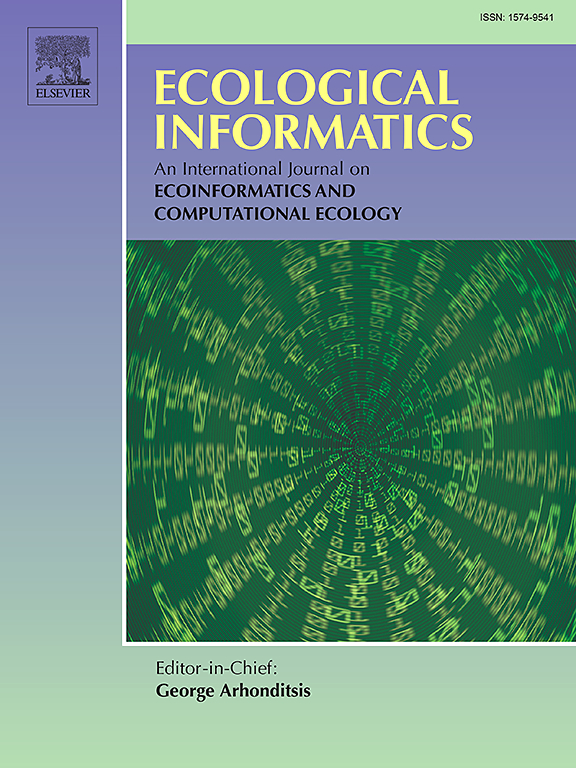利用深度学习从相机陷阱图像中识别基于身体部位的个体野猫
IF 7.3
2区 环境科学与生态学
Q1 ECOLOGY
引用次数: 0
摘要
野猫(Felis catus)是澳大利亚本土野生动物的重大威胁,通过捕食影响,至少有20种本土哺乳动物物种减少和灭绝。为了改进种群的识别和监测,需要对猫进行个体识别。本研究提出了一种基于身体部位的计算机算法方法,该方法使用深度学习从照片中进行个人识别,可以解决与使用相机陷阱相关的常见挑战,其中通常只呈现感兴趣对象的部分或模糊视图。我们研究了猫的四个身体部位的图像的歧视性属性:侧腹(“身体”)、后腿、前腿和尾巴。我们使用的是野猫数据集的一个子集,这些数据集是通过部署在澳大利亚维多利亚州格伦尔格和奥特威地区的相机陷阱收集的。由于数据集中每个个体的图像具有倾斜和不平衡的性质,我们使用了一个由10个个体组成的精选子集,每个个体具有相对相似的图像数量,结果总共有1644张图像。我们训练了具有ResNet-50主干的深度学习模型,分别对这些身体部位进行了训练,并通过特征拼接对多个身体部位进行了组合。结果表明,身体是识别猫的最具歧视性的部位,其次是后腿。当它们组合在一起时,其他部分会增加性能。我们得出的结论是,使用相机陷阱捕获的部分身体图像可以成功地识别单个猫。虽然身体是最具特色的部分,但该方法在身体被遮挡的情况下提供了灵活性。该研究表明,深度学习方法可以为相机陷阱图像分析做出有意义的贡献,从而促进环境保护成果。本文章由计算机程序翻译,如有差异,请以英文原文为准。
Body-part-based individual feral cat identification from camera trap images using deep learning
Feral cats (Felis catus) are a significant threat to Australia's native wildlife, contributing to the decline and extinction of at least 20 native mammal species through predation impacts. To improve the identification and monitoring of populations, individual identification of cats is required. This study proposes a body-part-based computer algorithmic approach that uses deep learning for individual identification from photos that can address a common challenge associated with using camera trapping, where often only a partial or obscured view of the objects of interest is presented. We investigated the discriminatory attributes of the images of four body parts of the cats: flank (‘body’), back leg, front leg, and tail. We use a subset of a dataset of feral cats collected using camera traps deployed across the Glenelg and Otway regions of Victoria, Australia. Due to the skewed and imbalanced nature of images per individual in the dataset, we used a curated subset of 10 individuals, each with a relatively similar number of images, resulting in a total of 1644 images. We trained deep-learning models with a ResNet-50 backbone on these body parts indivdually as well as combinations of multiple body parts through feature concatenation. Results demonstrate that the body was the most discriminatory part for cat identification, with the back leg the next best part. Other parts added to the performance when they were combined. We conclude that individual cats can successfully be identified using partial body images captured using camera traps. While the body was the most distinctive part, the proposed method provides flexibility in cases where the body is obscured. This study shows that deep learning methods can meaningfully contribute to camera trap image analysis, and hence environmental conservation outcomes.
求助全文
通过发布文献求助,成功后即可免费获取论文全文。
去求助
来源期刊

Ecological Informatics
环境科学-生态学
CiteScore
8.30
自引率
11.80%
发文量
346
审稿时长
46 days
期刊介绍:
The journal Ecological Informatics is devoted to the publication of high quality, peer-reviewed articles on all aspects of computational ecology, data science and biogeography. The scope of the journal takes into account the data-intensive nature of ecology, the growing capacity of information technology to access, harness and leverage complex data as well as the critical need for informing sustainable management in view of global environmental and climate change.
The nature of the journal is interdisciplinary at the crossover between ecology and informatics. It focuses on novel concepts and techniques for image- and genome-based monitoring and interpretation, sensor- and multimedia-based data acquisition, internet-based data archiving and sharing, data assimilation, modelling and prediction of ecological data.
 求助内容:
求助内容: 应助结果提醒方式:
应助结果提醒方式:


